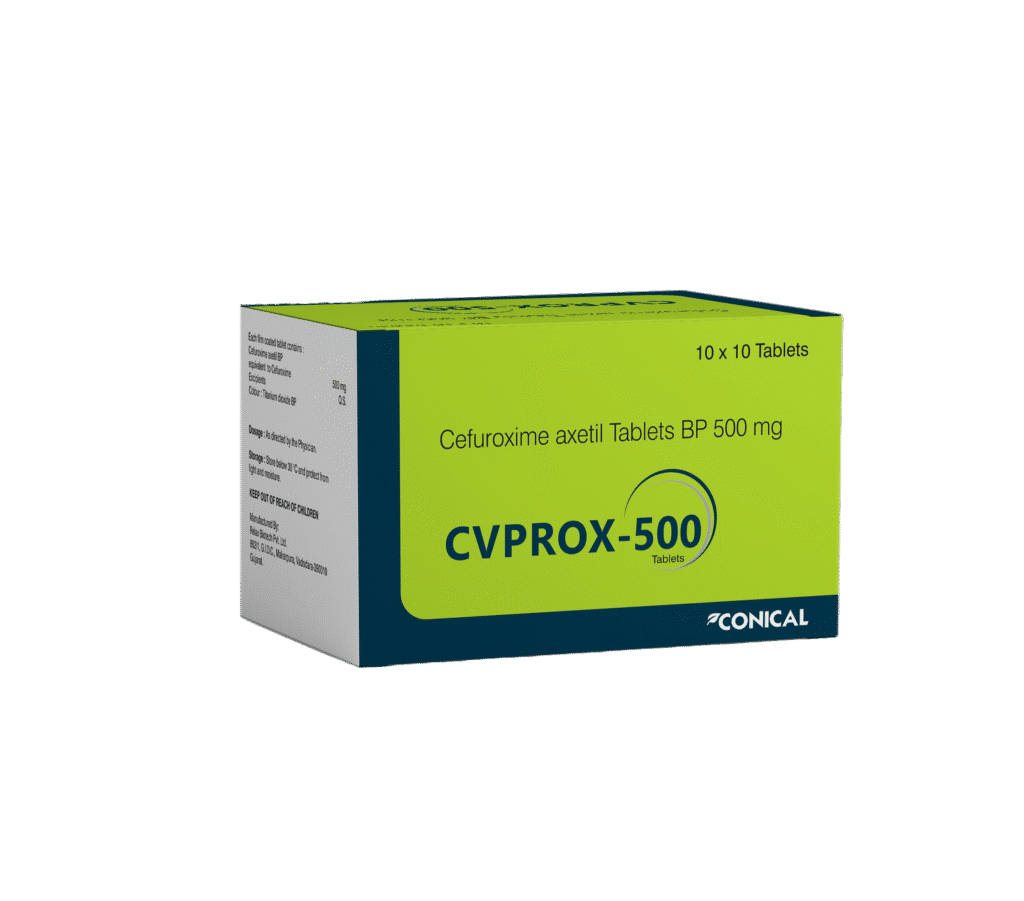







Allergy (Hypersensitivity) Risks while taking Cefuroxime Axetil Tablet.
Jarisch-Herxheimer Reaction
Overgrowth of Unwanted Germs
Risk of Severe Diarrhoea
Impact on Lab Tests
How to Take a Cefuroxime Axetil Tablet?
Typical Duration of Treatment
| Condition | Dose | Frequency |
| Tonsillitis, Pharyngitis, Sinusitis | 250 mg | Twice daily |
| Otitis Media, Bronchitis (flare-up) | 500 mg | Twice daily |
| Cystitis, Pyelonephritis, Skin Infections | 250 mg | Twice daily |
| Lyme Disease | 500 mg | Twice daily for 14 days (range: 10–21 days) |
Children < 40 kg
| Condition | Dose | Frequency |
|---|---|---|
| Tonsillitis, Pharyngitis, Sinusitis | 10 mg/kg (max 125 mg) | Twice daily |
| Otitis Media, Severe Infections (≥2 years) | 15 mg/kg (max 250 mg) | Twice daily |
| Cystitis, Skin Infections | 15 mg/kg (max 250 mg) | Twice daily |
| Pyelonephritis | 15 mg/kg (max 250 mg) | Twice daily for 10–14 days |
| Lyme Disease | 15 mg/kg (max 250 mg) | Twice daily for 14 days (range: 10–21 days) |
Typical Side Effects of Cefuroxime Axetil Tablet More than 1 in 100 people experience these:
Infections: Candida (yeast) overgrowth.
Blood Problems: Increase white blood cells called eosinophils.
Nervous System: lightheadedness and headache.
Digestive System: pain in the abdomen, nausea, and diarrhea.
Liver Function: A brief rise in liver enzymes that is typically reversible.
Reduced Frequency of Side Effects.
Less than 1 in 100 persons experiences this:
Coombs’ test results are positive, which could affect the results of blood transfusion tests.
Disorders of the Blood Cells: Low white blood cells (leukopenia), low platelets (thrombocytopenia)
Skin: Light rashes.
Digestive: Vomiting.
Rare or Unclear Frequency These are either very rare, or their frequency isn’t known.
Blood Reactions
Liver Effects
Children’s Safety
Store below 30°C and protect from light and moisture. Keep out of reach of children.
Alu-Alu blister packs.
Cefuroxime Axetil Tablet is available in an Alu-Alu blister of 10 tablets. Such are 10 blisters with package inserts in a unit box.
Contact us directly to receive full information on the product, the formulation, the science behind it, stability data, and more. Our Business Development Manager is a click away.
Questions are useful tools, they open lines of communication; give us information; improve interactions, facilitate analysis, and many more.
A pharma CMO is a special kind of an organization, offering contract manufacturing services to pharmaceutical companies for various kinds of drug formulations.
Reduce overall costs and time to market :
Contract manufacturers already have the needed infrastructure and technical staff, so working with a CMO or CDMO can decrease the cost of manufacturing your pharmaceutical products.
Scalability and flexible production capacity :
You can produce what you need when you need it without worrying about excess capacity. Additionally, CMOs understand the importance of quality and compliance, so you don't have to sacrifice safety for scalability.
Save on upgrading and maintaining equipment :
If you have your manufacturing facility, you’ll have to pay to upgrade your equipment as technology advances—which can get expensive. A CMO/CDMO’s only function is to make and distribute products, so part of their core business responsibility is to update their equipment whenever needed and perform maintenance.
Ease supply chain issues :
During the pandemic, there were several instances of supply chain issues, including medicine shortages. CMOs are generally better equipped than startups to handle a supply chain crisis.
Bandwidth to focus on core competencies
When your company resources aren’t directly allocated to manufacturing and distribution, you have more time to focus on other tasks, like marketing your new drug, researching, or working on drug discovery.
We have 7+ manufacturing sites with a minimum of WHO GMP certification and other country-specific approvals like NAFDAC approved, PPK Kenya Approved, TFDA Tanzania Approved, EU-GMP Approved.
We have below manufacturing capacity:
For Tablet, Capsule, and soft gel: up to 1 million units per shift
For Syrup: up to 0.05 Million per shift
For Ampoule and Vial: up to 0.1 million units per shift
For Ointment and Cream: up to 0.1 million units per shift
For Suppository: 0.1 Million units per shift
